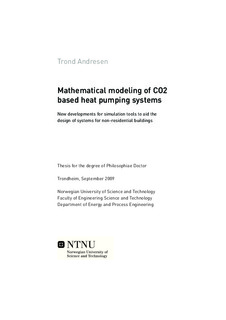| dc.contributor.author | Andresen, Trond | nb_NO |
| dc.date.accessioned | 2014-12-19T11:43:54Z | |
| dc.date.available | 2014-12-19T11:43:54Z | |
| dc.date.created | 2010-01-15 | nb_NO |
| dc.date.issued | 2009 | nb_NO |
| dc.identifier | 286762 | nb_NO |
| dc.identifier.isbn | 978-82-471-1756-9 (printed ver.) | nb_NO |
| dc.identifier.isbn | 978-82-471-1757-6 (electronic ver.) | nb_NO |
| dc.identifier.uri | http://hdl.handle.net/11250/233427 | |
| dc.description.abstract | CO2 based heat pumping systems have in recent years received considerable focus world-wide. Now, attention has been turned toward heating and cooling of larger, non-residential buildings. With plate heat exchanger’s now becoming available for CO2, this natural refrigerant becomes a real alternative for larger applications, considering both efficiency and economy.
However, research and design tools have not been readily available to fully design optimized systems for larger buildings. Simulation-aided design is particularly valuable for CO2 systems, as existing conventional systems cannot be used with good results. However, the special properties of CO2 both increase the need for discretization of component models, and require more complex fundamental equations for thermophysical properties. Because of this, circuit simulations with CO2 are considerably slower compared to simulation of conventional refrigerant systems, to the extent that it is limiting the ability to design optimal CO2 systems.
In this work, an existing circuit simulation tool, CSIM, has been extended and modified to be suited for efficient design and optimization of heat pumping systems with complex-configuration plate heat exchangers. The modification of CSIM performed in this work includes a versatile and configurable plate heat exchanger model, and a general method to handle more complex fluid stream configurations. The new model can describe the local behavior in individual, parallel flowing, plate channels, including asymmetric heat transfer, pressure drop and mass flow distribution.
Implemented into CSIM, this model can be used to predict the system performance impact due to local behavior in the component. A demonstration simulation case was carried out, comparing the predicted system performance using a simple uniform model, and the new advanced plate heat exchanger model. The results showed that the additional information in the new plate heat exchanger model could have a large impact on the predicted system performance.
A profiling of CSIM simulations on six test cases revealed that approximately 99.85% of the time was consumed calculating thermophysical properties for CO2. To increase the simulation performance, a new, considerably faster thermophysical library (FTL) for CO2 has been developed and implemented. FTL is based on linear interpolation in lookup tables containing pre-calculated values of CO2 properties. Through careful design of extracting functions and table grid, even the highly non-linear properties around the critical point was described with acceptable accuracy.
A test suite was performed, focusing on the accuracy and calculation speed compared to the reference equation of state. Overall, simulation results showed only very minuscule differences, but the simulation time was on average reduced from 945 seconds to 2.2 seconds, a reduction of 99.77%. This considerable reduction in simulation time will facilitate the more advanced component and system models needed to optimize CO2 system design. | nb_NO |
| dc.language | eng | nb_NO |
| dc.publisher | Norges teknisk-naturvitenskapelige universitet, Fakultet for ingeniørvitenskap og teknologi, Institutt for energi- og prosessteknikk | nb_NO |
| dc.relation.ispartofseries | Doktoravhandlinger ved NTNU, 1503-8181; 2009:180 | nb_NO |
| dc.title | Mathematical modeling of CO2 based heat pumping systems: New developments for simulation tools to aid the design of systems for non-residential buildings | nb_NO |
| dc.type | Doctoral thesis | nb_NO |
| dc.contributor.department | Norges teknisk-naturvitenskapelige universitet, Fakultet for ingeniørvitenskap og teknologi, Institutt for energi- og prosessteknikk | nb_NO |
| dc.description.degree | PhD i energi- og prosessteknikk | nb_NO |
| dc.description.degree | PhD in Energy and Process Engineering | en_GB |
